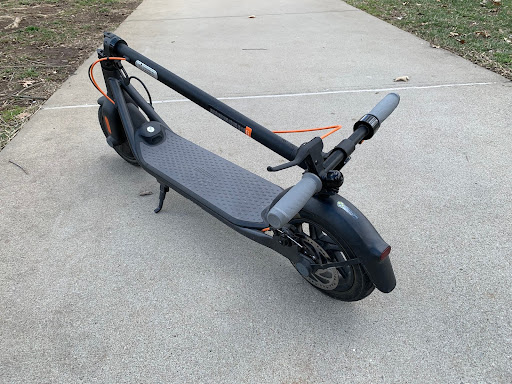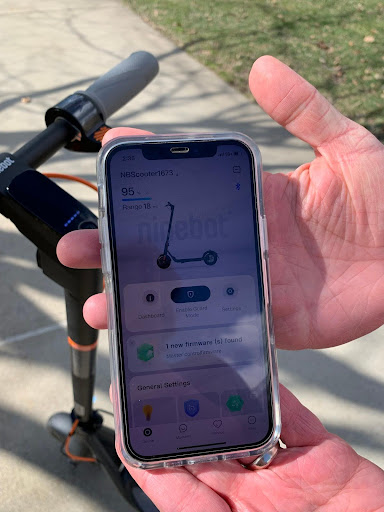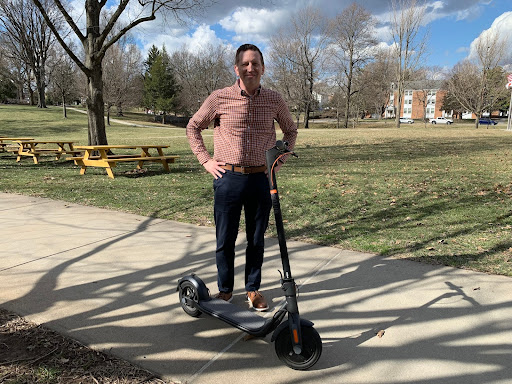by Connor Parks
2022 Segway Ninebot Kickscooter F30 (owned by Kendrick Durham)
I was only a first-year. It was a crisp fall morning with a robin’s egg sky back in 2023, and I was making my way to Crounse on a day like any other when abject horror struck. As I briskly walked, it came without warning: a sudden whir, a nonchalant “watch out” from my left, and the future of human mobility breezing by me, nearly knocking me off my feet to certain death. How I ever recovered I still don’t know, but one thing was sure: the scooter man had made himself known–and nobody was safe.
I should probably preface this. I’m a car guy. I know next to nothing about scooters aside from my extensive neighborhood Razor experience well over a decade ago, which left me with more than a few permanent ankle scars. This thing, though, was just too iconic of a campus vehicle not to warrant me reviewing it, and Kendrick gladly agreed. He’s aware of his status as “scooter guy” around campus, and he takes it with utmost pride. The Ninebot began as a gift from his wife, who had noticed him eyeing it time and time again on visits to Sam’s Club and decided to take matters into her own hands. He claims it cost around $400 at the time (about 2-3 years ago), and I’m seeing the same model within the $215 range now–an absolute steal, if you ask me. As far as basic stats go, it gets about 18 miles per charge, which (on average) gets Kendrick about a week’s worth of use and only takes a few hours to charge from 0 to 100% battery. Its top speed is about 15 miles per hour, and he loves to max it out regularly. It comes standard with carbon disc brakes, activated with a handbrake like a bicycle, which stop it quickly but never jarringly. It weighs about 25-30 pounds, but feels a lot lighter: it’s pretty front heavy and incredibly easy to carry if you pick it up and fold it correctly. To do this, one only has to turn a lever on the main steering column, fold it down, and place the latch which chimes the bell over a little knob on the space over the rear wheel–simple as that.

The entire scooter is controlled by what Kendrick refers to as a “handy little app”, which basically treats the thing like a car. I could go on about technological overreliance for basic transportation, but that’s for another article, probably about a Tesla (submit one for a review if you’ve got one, please). Regardless, the app is laden with features and constant data, like ride distance and speed, voltage and battery current, charge, vehicle temperature (why this matters I’m still unsure), etc. Although it isn’t street legal, you can also switch between the scooter’s three driving modes (I wish I was kidding): standard, eco (battery-saving), and sport (fastest and least battery efficient) exclusively through the app just like any modern car. Additional uses of the app include adjusting the headlights (regular or flashing), taillights, brakelights, and safety features for nighttime usage.

Given all the bells and whistles, I know you’re asking the real question now: how’s the drive? The answer, quite simply, is WAY more fun than I even imagined. You’ve got to kick it up to about two mph before the throttle actually engages, which requires a few good kicks off like a regular scooter before you pull the little orange trigger and it zooms to life. When it goes, it GOES–I had no idea the acceleration would be so rapid, but I went from a slight sweep of my foot to about ten mph in no more than two seconds. That’s the perk of an electric vehicle–immediate acceleration is basically a given, and this is one case where it seriously thrills. I sped around the area outside Cowan for a few minutes (that could’ve easily become a few hours if I’d had the time) with the widest of grins on my face. Stability is only ever a concern on rougher terrain due to the closeness of the handlebars causing issues in tighter turns, but this is rare. I only felt this when I tried turning a sharp right and had to slow down significantly. The day of the review, Segway had actually emailed Kendrick (great customer service, if you ask me), informing him that their upcoming model is slated to hit 28 mph. He wonders how that’s even possible or safe and is more than comfortable with what he’s got now as efficient, convenient, cross-campus and home-to-school transport. He lives close to Centre and, as he puts it, could quite honestly walk, but finds this much more fun. I don’t blame him one bit. And despite its functionality, it still only sees seasonal use: a self-admitted hater of winter weather, he tends to drive his truck during the colder months, and as an avid cyclist, he doesn’t prefer getting out in anything below about 50 degrees. In two years, he’s taken the scooter just under 170 miles, but I’m sure there’s thousands more to go in the future.
Quite frankly, at $215, I don’t understand why there aren’t more of these things for inter-campus transport around here. Aside from the overreliance on a mediocre app for all its functions, I genuinely couldn’t find anything to complain about with this great little scooter. Excellent battery life, superb speed, ease of carry, and simple technology: what’s not to love? It’s a little goofier than the alternative of walking, sure, but there’s loads of contexts in which I can see these things being absolute lifesavers, especially on a larger, state school campus. If you’re considering joining Kendrick in the tight-knit cadre hellbent on terrorising innocent pedestrians, now may be the very time to bite the bullet and make that worthy investment. You can thank me later–somewhere around 15 miles per hour.
Want to see your ride featured? Feel free to submit it by contacting connor.parks@centre.edu. Safe travels!

